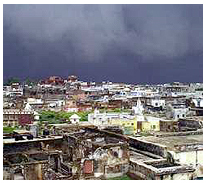



© 1999 VNN
|
WORLD August 6, 1999 VNN4447 Comment on this story Chaitanya's Braj - 484 Monsoons Later BY FRIENDS OF VRINDAVAN  VRINDAVAN, INDIA, Aug 6 (VNN) — "The arrival of Monsoon is magnificent. The developing storm resonates on the horizon and the atmosphere eerily darkens. Winds rush hissing, through the arching trees. Indra's storm increases in tempo like a 'raga' building to a crescendo, then finally overhead, the bravura performance of the hardest rain, deafening thunder rolls and multiple lightning claps - leave one humbled before the power ". VRINDAVAN, INDIA, Aug 6 (VNN) — "The arrival of Monsoon is magnificent. The developing storm resonates on the horizon and the atmosphere eerily darkens. Winds rush hissing, through the arching trees. Indra's storm increases in tempo like a 'raga' building to a crescendo, then finally overhead, the bravura performance of the hardest rain, deafening thunder rolls and multiple lightning claps - leave one humbled before the power ". Monsoon has arrived in Braj, the peacocks call, display and dance. It is the eye of a peacock's tail feather that crowns Lord Krishna's naturalness and divinity. As the 'Parama Purusha' (the Absolute Being) Krishna is in love with 'prakriti' (nature). His love is not to subjugate or exploit nature, but to celebrate it through 'Rasa Lila'. During the 'Van-Yatra' pilgrims travel around the forests of Braj enjoying the lilas that - in a processional theatre - re enact the exploits of Krishna and his friends. For it is in the greenery of the land of Mother Earth that true divinity lies and where it must be protected and celebrated by us, her children. If one is Krishna conscious then one is also Braj conscious, for we are not one without the holistic other This Monsoon is the twelfth consecutive successful season and after the first downfall the Braj landscape is crystal clear and reborn.. Temperatures have plummeted to 26¡ C. (82¡ F). The God of Storms has quenched the Brajbasi's thirst and drenched Brajboomi.  The sacred geography and locations of Krishna's lilas in Vrindavan and Braj were rediscovered and recreated by Lord Chaitanya during his nine months pilgrimage in 1515. Then Temples were built, ghats constructed and a literary dimension of philosophy, poetry, history was created by Lord Chaitanya's six Goswami companions, who stayed behind in Braj continuing the recreation. But the now vast literary dimension is incomplete if the physical arena of Krishna's plays is not available. The natural Lila settings are disappearing before us and the poisonous pollution of Kaliya has returned to the Yamuna. The sacred geography and locations of Krishna's lilas in Vrindavan and Braj were rediscovered and recreated by Lord Chaitanya during his nine months pilgrimage in 1515. Then Temples were built, ghats constructed and a literary dimension of philosophy, poetry, history was created by Lord Chaitanya's six Goswami companions, who stayed behind in Braj continuing the recreation. But the now vast literary dimension is incomplete if the physical arena of Krishna's plays is not available. The natural Lila settings are disappearing before us and the poisonous pollution of Kaliya has returned to the Yamuna.  In Krishna's day if a bird overflew the Yamuna it would fall dead from the sky, such were Kaliya's toxic fumes. Krishna confrontationally dealt with the problem of pollution, he beat it up and banished it. These days we Vaishnavas are the problem and the truth of the environmental degredation of Braj is a difficult subject to sustain devotee interest or even participation. In Krishna's day if a bird overflew the Yamuna it would fall dead from the sky, such were Kaliya's toxic fumes. Krishna confrontationally dealt with the problem of pollution, he beat it up and banished it. These days we Vaishnavas are the problem and the truth of the environmental degredation of Braj is a difficult subject to sustain devotee interest or even participation.  Monsoon was always scrupulously punctual but these days it has become elusive. It is often late if it comes at all in many areas of India. Deforestation is one of the reasons for this. Trees help to make rain. Forests seed the passing clouds. Monsoon is the important season to nurture young trees. Now is the time to transplant saplings from nursery to forest. Now is the time to regenerate the Lila groves. Trees for life. Trees for the preservation of Vaishnava devotional culture in Vrindavan, the greatest 'living' cultural region in the World. Now as we read these words is the moment of action or of indifference. Monsoon was always scrupulously punctual but these days it has become elusive. It is often late if it comes at all in many areas of India. Deforestation is one of the reasons for this. Trees help to make rain. Forests seed the passing clouds. Monsoon is the important season to nurture young trees. Now is the time to transplant saplings from nursery to forest. Now is the time to regenerate the Lila groves. Trees for life. Trees for the preservation of Vaishnava devotional culture in Vrindavan, the greatest 'living' cultural region in the World. Now as we read these words is the moment of action or of indifference. During May and June, FoV 'malis' (gardeners) collected seeds from the blossomed-out trees and planted them in our nurseries, hand delivering sweet water for the young seedlings. Mercifully the Monsoon is now doing the irrigation. There are 50, 000 one year-old saplings growing from 1998 and this year we are planting approximately 150, 000 mixed seeds including Banyan, Bel, Kadamb, Mango, Neem, Nimbu, Pipal and Tamal. Is it enough? No, but limited manpower and resources restrict this Seva. The Pipal tree (Ficus religiosa) is so named in Latin because of its usual proximity to temples or shrines as much as its astounding ability to manufacture non-stop oxygen in far greater quantities than any other tree.  Trees scrub the atmosphere of carbon dioxide (a global warming gas). The Lakshadweep islands and the Maldives, a scattering of small coral islands in the Indian Ocean, are terrified greenhouse gas emissions will lead to global warming which will melt the ice caps, raise the sea level and drown the islands. http://www.enn.com/specialreports/climate/players.asp Trees scrub the atmosphere of carbon dioxide (a global warming gas). The Lakshadweep islands and the Maldives, a scattering of small coral islands in the Indian Ocean, are terrified greenhouse gas emissions will lead to global warming which will melt the ice caps, raise the sea level and drown the islands. http://www.enn.com/specialreports/climate/players.aspDuring Monsoon Yamuna ji rises to clean herself and wash away the garbage and pollution desecrating her banks. The average flow of water in other seasons is not enough to self clean the river. In spate the river dislodges thousands of tons of 'jal khumbi' (water hyacinth, Eichhornia crassipes). At times Yamuna ji is a green carpet of floating jal khumbi as she flows east to 'Sangam'. Jal khumbi strangles static waterbodies, kunds and tanks forming an impenetrable layer that kills organisms living below the surface. http://www.mathura-vrindavan.com/mathura/lake.htm As Trees purify the atmosphere with oxygen their root systems protect moisture content in the soil and underground water supply. The Vedic tradition of building temple tanks had the dual purpose of providing fresh water for ritual whilst maintaining aquifer levels for times of drought. Water needs to be caught and held where and when it falls. To harvest the gift of Monsoon and channel the water from rooftops into soakpits for seepage to the underground supply would very cheaply rescue millions of gallons of water from run off into Yamuna. A sapling in Braj must be watered throughout the year, organic manure added and the tree guard extended if the tree grows on well. Tree guards are essential unless the planting is protected by a perimeter wall. A bamboo guard costs Rs. 250 (US$ 6. 50) and in metal Rs. 500 (US$ 11. 00). Guards protect young saplings from browsing cows, pigs, goats, camel and of the totally destructive monkeys (rhesus macaque) that live in the Vrindavan concrete jungle; having lost their natural habitat to us (there are plans to reduce their numbers again, 600 were relocated three years back). Other hazards are human: the poor need fuel for cooking and Babul (camel thorn, Acacia arabica) and forest litter has traditionally provided this. Population explosion has hastened deforestation, fuelwood demand exceeds the supply of dead biomass material or alternatives. The dead use wood for their cremation. Then living greenwood gets pillaged. To bring up a single tree is fraught with danger; to bring up a forest a monumental challenge. But "Trees for life" of Vraja is essential Seva. We are all custodians of Brajbhoomi, not its owners. Who can own what is Krishna's ? Chief Seattle declared in 1854, "How can you buy or sell the sky, the warmth of the land? The idea is strange to us. If we do not own the freshness of the air and the sparkle of the water, how can you buy them?  Friends of Vrindavan are planting now in Braj. We have also been given the use of, not ownership of, some plots of land by their owners to grow trees, the work is funded by the owners and the trees donated by FoV. Today there is a new partnership developing in Vrindavan, that a local core group is making a huge effort to initiate. Partnership will overcome partisanship. FoV are hoping that other international organisations such as Iskcon which own plots of land on the Vrindavan entry road will plant them this Monsoon, rather than the land lying unused. This is being discussed now in Vrindavan and with Iskcon. It is highly unlikely that construction will be allowed on this green belt land in the future, especially of guesthouses which was the intention behind most of the speculative purchases. (for a further overview of Vrindavan ecology). http://vaishnava-news-network.org/world/WD9907/WD13-4291.html Friends of Vrindavan are planting now in Braj. We have also been given the use of, not ownership of, some plots of land by their owners to grow trees, the work is funded by the owners and the trees donated by FoV. Today there is a new partnership developing in Vrindavan, that a local core group is making a huge effort to initiate. Partnership will overcome partisanship. FoV are hoping that other international organisations such as Iskcon which own plots of land on the Vrindavan entry road will plant them this Monsoon, rather than the land lying unused. This is being discussed now in Vrindavan and with Iskcon. It is highly unlikely that construction will be allowed on this green belt land in the future, especially of guesthouses which was the intention behind most of the speculative purchases. (for a further overview of Vrindavan ecology). http://vaishnava-news-network.org/world/WD9907/WD13-4291.htmlThank you for reading. assembled by Friends of Vrindavan. Gambhira. Jai Singh Ghera. Vrindavan. U. P. 281121 (Tel: + 0565 442087) gambhira@vsnl.com Comment on this story
|